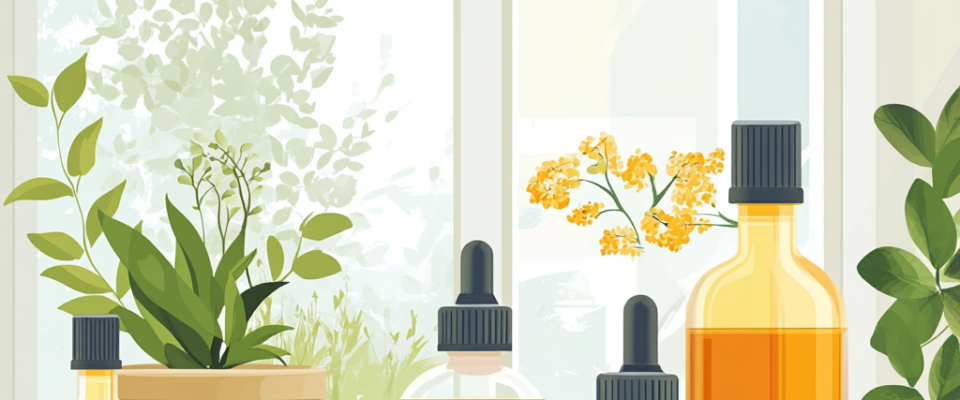- The main properties of essential oils and their effect on the atmosphere in the interior
- Selection of essential oils depending on the purpose of the room
- Methods of using essential oils in the interior
- Combining and creating aromatic compositions
- Safety and precautions when using essential oils
- Popular scents and their psychological effects on home inhabitants
- Questions and answers
The main properties of essential oils and their effect on the atmosphere in the interior
Essential oils are concentrated extracts obtained from various parts of plants, including flowers, leaves, roots and bark. They are known for their powerful aromas and ability to affect a person’s emotional and physical state. In the interior, essential oils can create a certain atmosphere, improving the quality of life and overall mood. Thus, lavender and chamomile oils are famous for their calming effect, helping to relieve stress and improve the quality of sleep. Lavender in particular is used to combat insomnia and anxiety, creating a calm and cozy environment in the bedroom.
Citrus oils such as lemon and orange have the opposite effect, filling the room with invigorating energy and optimism. They are ideal for use in workspaces and living rooms where concentration and good mood are needed. Lemon oil not only stimulates mental alertness, but also helps neutralize unpleasant odors, making it ideal for use in the kitchen. Thus, the choice of essential oils allows you to adapt the atmosphere of the room to specific needs and moods, creating a harmonious and comfortable space.
Selection of essential oils depending on the purpose of the room
When choosing essential oils for different spaces, it is important to consider not only the aroma, but also the functional characteristics of those spaces. For example, oils with relaxing properties such as sandalwood, vanilla and frankincense are often used in the bedroom. These aromas promote relaxation, meditation and deep rest. Sandalwood oil has a warm, woody aroma that helps create a cozy and safe atmosphere, ideal for evening relaxation.
In contrast, for a living room or study, you can choose more stimulating and refreshing scents such as mint, rosemary or grapefruit. Peppermint oil stimulates mental alertness and helps fight fatigue, making it ideal for use in work areas. Rosemary, in turn, improves memory and concentration, which is useful for study and professional activities. In the kitchen, where it is important to maintain cleanliness and freshness, you can use lemon, grapefruit or tea tree oils, which have deodorizing and antibacterial properties.
Methods of using essential oils in the interior
There are many ways to use essential oils in the interior, and the method chosen depends on the desired effect and available resources. One of the most common methods is to use aroma diffusers, which diffuse essential oils into the air using water or heat. Electric diffusers, for example, work using ultrasonic vibrations to create a fine mixture of water and essential oil. This method allows you to evenly saturate the air with aroma and control its intensity.
Another popular method is aroma lamps, which use the heat of a candle to vaporize essential oils. This is a traditional method that creates not only a scent, but also a cozy atmosphere thanks to the soft light of a candle. Scented candles and wax fragrances are also very popular as they are easy to use and can serve as a decorative element for the interior. Finally, essential oils can be used in homemade room sprays to quickly freshen the air in any room. To do this, just mix a few drops of oil with water and alcohol in a spray bottle.
Combining and creating aromatic compositions
Creating aromatic compositions is an art that allows you to individually customize the atmosphere in a room based on personal preferences and moods. When combining essential oils, it is important to consider their main notes and properties. Base notes are the initial scents that are felt immediately upon application, which eventually give way to middle and base notes. For example, citrus oils have bright and fresh base notes that pair perfectly with herbal or floral oils to create fresh and invigorating compositions.
To create a relaxing atmosphere, you can combine lavender and bergamot oils. Lavender has calming properties, while bergamot adds a fresh and light citrus note. If the goal is to create a romantic atmosphere, you can use ylang-ylang and rose oils. These oils have sweet and deep aromas that create a sensual and sophisticated atmosphere. It is important to remember to use moderation when creating compositions and avoid excessive amounts of oils to avoid saturation and discomfort.
Safety and precautions when using essential oils
Essential oils have a high concentration of active substances, and their improper use can cause unwanted reactions. First of all, essential oils should not be applied to the skin in their pure form, as this can lead to burns or allergic reactions. To be safe for use on the skin, oils must be diluted in a carrier oil such as coconut, almond or jojoba. The recommended concentration is usually 1-2% essential oil to 98-99% base oil.
Additionally, some essential oils can be toxic to pets, especially cats, which are unable to metabolize certain components. For example, tea tree oil can be dangerous for cats, causing toxic reactions. You should also use essential oils with caution in the presence of pregnant women and young children, as their bodies may be more sensitive to the active substances. At When using diffusers and aroma lamps, it is necessary to ensure good ventilation of the room to avoid oversaturation of the air with aromatic substances, which can cause headaches or discomfort.
Popular scents and their psychological effects on home inhabitants
Essential oils, like perfume, not only create a pleasant atmosphere in the house, but also have a psychological effect on its inhabitants. Let’s look at several popular oils and their effects:
- Lavender – helps relieve stress, improve sleep and overall emotional well-being.
- Lemon – invigorates, improves mood, improves concentration.
- Mint – refreshes, relieves fatigue, helps with headaches.
- Rose – creates a romantic atmosphere, improves emotional state, relieves tension.
- Tea tree has antiseptic properties, helps fight colds and purifies the air.
These oils can be used individually or combined to create unique scents for different spaces. For example, you can choose relaxing lavender for the bedroom, stimulating lemon for the study, and cleansing tea tree for the bathroom. It is important to remember that the scents must be pleasant to all inhabitants of the house in order to create a harmonious and comfortable atmosphere.
Questions and answers
Answer 1: Lavender, sandalwood and vanilla oils can be used to create a soothing atmosphere in the bedroom.
Answer 2: Rosemary, mint and lemon oils are suitable for improving concentration in the office.
Answer 3: Essential oils should be diluted in a carrier oil such as coconut or almond oil at a concentration of 1-2%.
Answer 4: Not all oils are safe for pets; for example, tea tree oil can be toxic to cats.
Answer 5: Aroma diffusers allow you to distribute the aroma evenly in a room.

